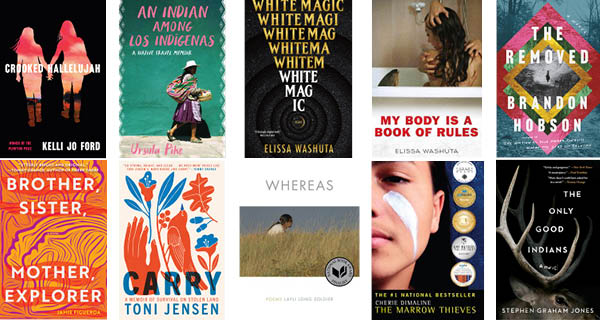
Editor's Note: Check out author Chip Livingston's upcoming Winter Session class, 4-Week: Reading as a Writer—Traditional Craft in Contemporary Native Literature. If you can't wait for a Reading as a Writer class, check out Melissa Alvarado Sierra's soon-to-start class on Rosario Ferré's The Youngest Doll.
Here we are in early November fretting over election results and challenges and, somewhere in our blog and social media newsfeeds, finding links to new reading lists pertaining to Native American authors and Native American Heritage Month. I teach creative writing at the Institute of American Indian Arts in Santa Fe, New Mexico, so Native arts and literature are always on my radar and my reading lists, but today, the day after the presidential election in the United States, I turned off the news cycle and returned to finish Kelli Jo Ford’s brilliant Crooked Hallelujah. Ford’s debut novel of four generations of Cherokee women surviving natural and “men-made” disasters in Oklahoma and Texas has been my fictional retreat of late, and today it made for the perfect escape from checking vote count updates.
I not only calmed with Reney’s southern solid voice, which narrates the novel’s final lyric section as she faces what seems like the end of the world; I thought about the novel’s linked construction, its perfect imagistic ending, as well as how fiction reading in general often provides that needed break from a reader’s “real life” world. I also thought about how stories can inform us, and comfort us, by showing characters confronting injustice and conflict, internal and external. Then I thought how every Native-authored book is a survival story, simply in the fact that its author survived repeated attempted genocide to bring the words into print. So what better texts to turn to in uncertain historical, climactic, political times than those written by long-term survivors of these very same threats?
While there are a plethora of great lists of new Native literature circulating the internet, from Nambé Pueblo Debbie Reese’s American Indians in Children’s Literature to Apache/Chickasaw/Cherokee author Erika Wurth’s Buzzfeed post to Oprah Winfrey’s recent recommended Native authors to read right now, Lighthouse invited me to share what books I’ve been recently most excited about, and I’m delighted to do so.
As mentioned, Kelli Jo Ford’s Crooked Hallelujah I just finished today, and it’s a title I’ll teach and recommend with enthusiasm for years to come. The book I finished just before that, which will soon be on everyone’s list, is Karuk author Ursula Pike’s debut memoir, An Indian Among Los Indígenas, about her two years in the Peace Corps living among an indigenous community in Bolivia. And the next book I’ll start tonight, which I’ve been very eager to open, is White Magic, a new collection of essays from Cowlitz memoirist Elissa Washuta, whose first essay collection, My Body is a Book of Rules, is always among the books I teach with (and one I think should be required reading for every college freshman). Other forthcoming books I’m looking forward to read include Cherokee author Brandon Hobson’s The Removed and debut novels from Taino author Jamie Figueroa and Navajo filmmaker Ramona Emerson.
As for the books most recently published I’ve been returning to and buying for friends and family members, as well as those newest on my teaching lists, include Toni Jensen’s Carry, Stephen Graham Jones’ The Only Good Indians; Cherie Dimaline’s The Marrow Thieves and Empire of Wild; Eden Robinson’s Trickster series; Tommy Orange’s There, There; Terese Mailhot’s Heart Berries; Brandon Hobson’s Where the Dead Sit Talking; Linda Hogan’s A History of Kindness and The Radiant Lives of Animals; Layli Long Soldier’s Whereas; Natalie Diaz’s Postcolonial Love Poem; Erika Wurth’s You Who Enter Here; Dennis Staples’ This Town Sleeps; Billy Ray Bellcourt’s This Wound is a World and A History of My Brief Body; David Heska Wanbli Weiden’s Winter Counts; Jake Skeets’ Eyes Bottle Dark with a Mouthful of Flowers; and of course, When the Light of the World Was Subdued, Our Songs Came Through: A Norton Anthology of Native Nations Poetry edited by Leanne Howe, Jennifer Foerster, and U.S. poet laureate Joy Harjo, in which I’m honored and humbled to have a poem included.
Additional contemporary favorites that are standards on my teaching lists include Debra Magpie Earling’s Perma Red; Joy Harjo’s Crazy Brave; Ernestine Hayes’ The Tao of Raven; Gordon Henry Jr.’s The Light People; Linda Hogan’s Power; N. Scott Momaday’s The Way to Rainy Mountain, and Leslie Marmon Silko’s Storyteller.
The world of Native American literature is as vast and varied as the diverse membership of the many, many Native nations surviving in North America, and this week, this month, this year is a terrific time to read further into this longstanding American canon.

